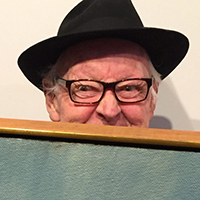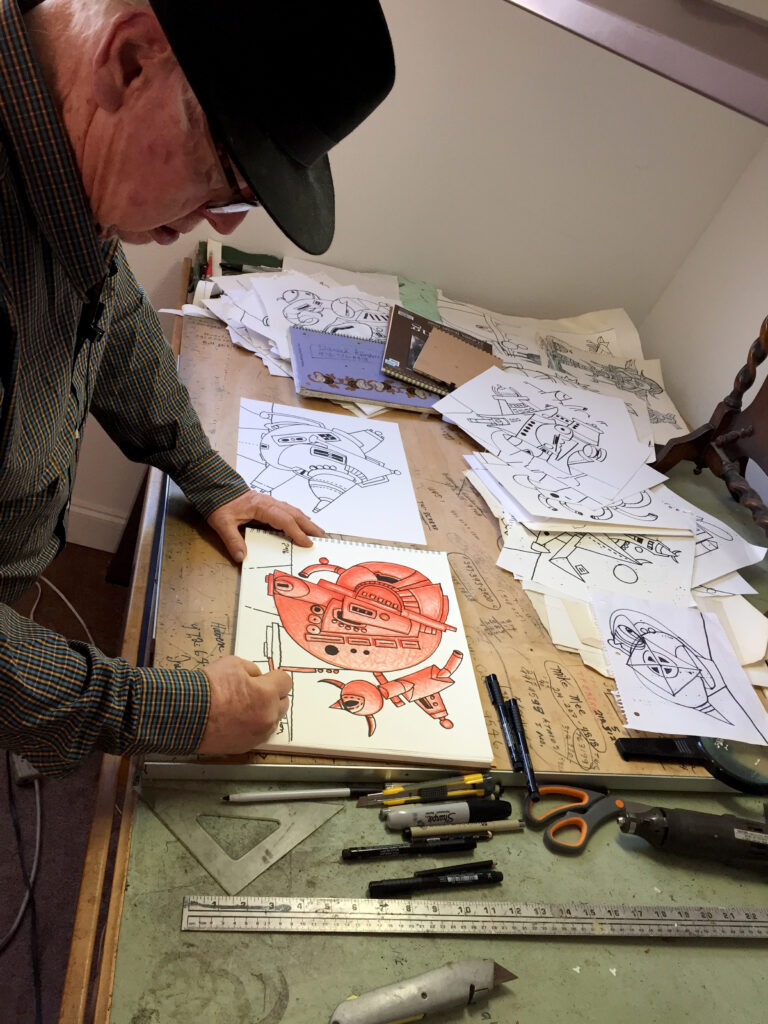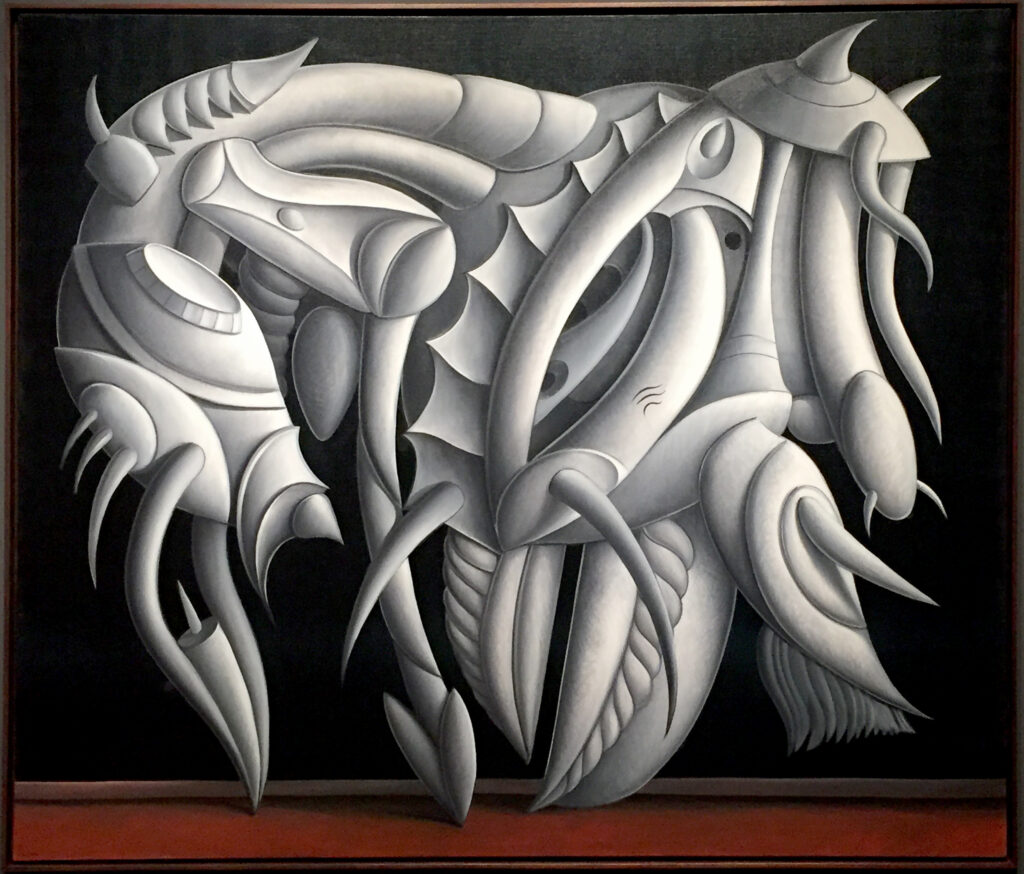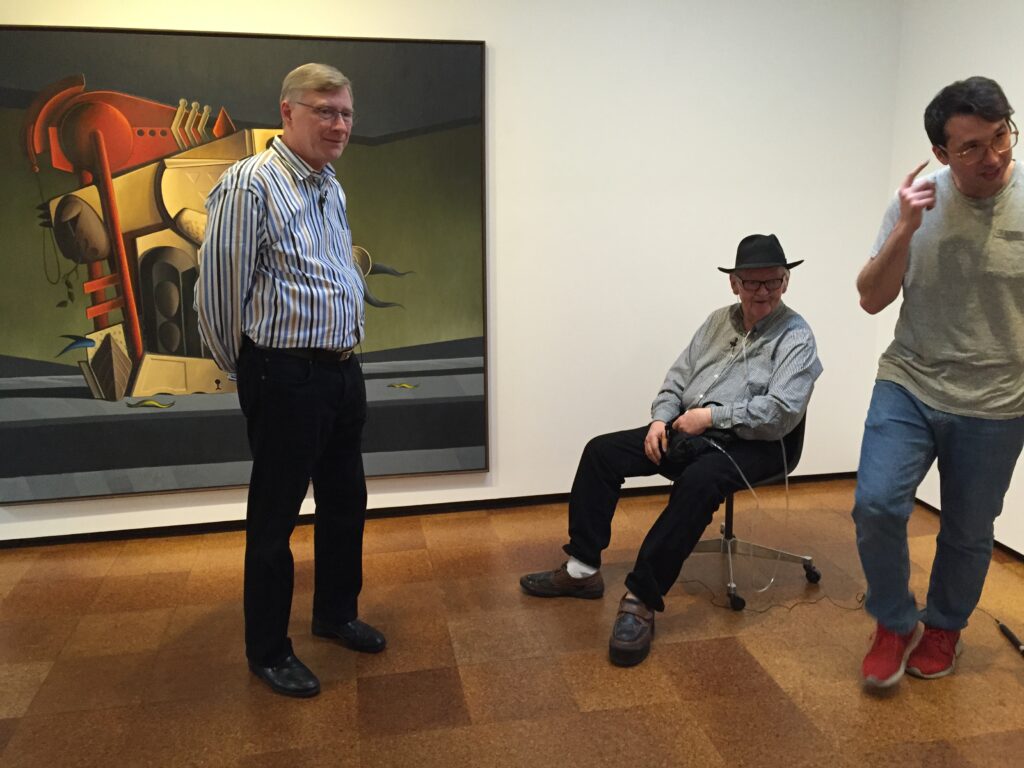
A VISIONARY PAINTER’S TECHNO-BAROQUE WORLD
The creator of an imaginary land of strange, mechano-organic, soulful “shapes” tells his story in a film made just before he died
Valton Tyler: Flesh is Fiction
A film produced by Edward M. Gómez and Chris Shields
Ballena Studio, 2017
Running time: Approximately 42 minutes
Edward M. Gómez reports:
Was the late Valton Tyler (1944-2017), a self-taught artist who spent most of his life living and working in and near Dallas, Texas, one of the greatest painters of his time in the United States?
Or, looking back at a prolific career that began with an energetic Wunderkind phase and produced one of the most unusual, original, hard-to-classify bodies of work anywhere in the annals of modern art, one might ask: In his lifetime, why was Tyler’s fascinating oeuvre, which was so masterfully crafted and unparalleled in the sheer oddness of its aesthetic and narrative vision, not better known?

In early 2017, the Amon Carter Museum in Fort Worth, Texas, presented Invented Worlds of Valton Tyler, a mini-retrospective of the artist’s work, which the then-ailing painter lived to see. That survey focused on a large series of etchings Tyler had produced in the early 1970s, when he was in his twenties, and on the evolution of his illusionistic oil paintings, for which he had become best known. During the last two decades of Tyler’s life, his canvases grew ever larger in size, and their compositions became noticeably more ambitious and complex.
I first met Tyler in the summer of 2000, when I traveled to Dallas to see a small exhibition of his paintings at The MAC, a local arts center, and to write about it for the New York Times. That encounter with the warm, self-effacing, genuinely eccentric artist and my introduction to his circle of friends and admirers provoked what would become a deep interest in his peculiar art and a search for an understanding of the ideas and life experiences that had shaped it.

From that time until his death, including with the first-ever film about Tyler that the cinematographer Chris Shields and I produced in 2017, I became the main art historian and critic who was consistently following the artist’s development. I presented my research in numerous published articles and essays. (Below, you will find a list of some of these past, published writings, with links to website pages on which they may be viewed.)
In a review of the Amon Carter Museum exhibition that was published in Hyperallergic in March 2017, I summarized Tyler’s background like this:
“Tyler was born in 1944 in Texas City, southeast of Houston, on the Gulf Coast. […] In April 1947, when Valton was three years old, an event that became known as the worst industrial accident in U.S. history took place when a cargo ship carrying more than 2000 tons of ammonium nitrate caught fire and blew up in Texas City’s port, causing massive fires and further explosions as other ships and a nearby oil refinery went up in flames.”
That article continued: “In numerous in-person interviews I have conducted with the artist over the past several years, Tyler has told me that the terrifying images and emotions of that day have stayed with him all his life.”

“During Valton’s childhood, the future artist’s father suffered from debilitating bouts of depression and was frequently hospitalized. The Tylers’ family life was fractured. As a result, when Valton was a teenager, along with his mother and sister, he moved to Dallas, where his older brother already had settled and found work as a draftsman for an architectural firm. In Dallas, Valton enrolled in a technical high school but rarely attended classes, preferring to spend long hours at the public library reading about art, including the work and ideas of various Renaissance masters, Francisco Goya, Paul Gauguin and Vincent van Gogh. He did hand-embossing and layout work for an engraving company and became a student at the school that is now the Art Institute of Dallas, although, once again, he rarely showed up for classes.”
Even today, if you travel to Dallas and start poking around its arts community, you’ll find that many of its members have colorful recollections of Tyler. Locally, he became known as a lovable eccentric. Of his antics as a young man in one of the largest cities in Texas, Tyler once told me, “I smoked too much, I drank too much, and I had a good time, but I also worked very hard. I lived to draw and paint. As soon as I finished one drawing or painting, I couldn’t wait to start working on the next one.”
Some of Tyler’s friends told me about the time he covered his jeans with drawings and, worn out from what would later be recognized as episodes of bipolar disorder, checked himself into a local psychiatric hospital, although he did not stay long. Then there was the period during which Tyler ate only baby food. Why? Years later, he explained that he had been afraid of choking on or even being poisoned by solid food.
In our film, Valton Tyler: Flesh is Fiction, Tyler opens up and describes what he sometimes referred to as his personal relationship with his colorful art’s unusual, semi-abstract subject matter. Exactly what did he depict in his paintings? Are they buildings or robotic plants?

Interviewed in the film, Tyler observes, “Gauguin said that the shapes will tell you pretty much what their colors should be, and that is sort of the way I feel. […] Some designs like to be just one color, and then some like to be mixed colors.” About his own strange images, he says, “Nothing has a meaning. Everything is just — shapes. I try to make them communicate with each other. […] Each shape has feelings.”
When I visited the Amon Carter Museum and examined its superb collections of 19th- and 20th-century American masterworks by such artists as Frederic Edwin Church, Martin Johnson Heade, Winslow Homer, Thomas Eakins, Stuart Davis, and Georgia O’Keeffe, it seemed clear to me that Tyler’s work could easily hold its own alongside the distinctive creations of such canonical figures.
In the New York Times, in June 2000, I wrote that, in trying to label Tyler’s art, “‘visionary’ seems [to be] the right word for describing his vivid, unusual and technically refined paintings, prints and drawings, whose style defies convenient labels.” I noted that his work could also be referred to as abstract, surreal, cartoonish, sci-fi fantastic, metaphysical, or apocalyptic-baroque, but that all of these terms both fit and fall short of fully, accurately describing his art.
Chris Shields joins me in inviting you to take a moment to watch our film about the Valton Tyler and to get to know the art-maker and the man.
You may view our film here, in its entirety, free of charge. We hope you will enjoy it.
Resources:
All of the following articles and essays were written by Edward M. Gómez.
“Valton Tyler (1944-2017),” obituary, Raw Vision, issue RV96, winter 2017/2018, page 15.
“Valton Tyler’s Techno-Organic Landscapes,” Raw Vision, issue RV 35, Summer 2001, pages 34-39.
No live link to this article is available now, but a copy of the print-edition magazine may be purchased here: https://rawvision.com/shop/raw-vision-35



